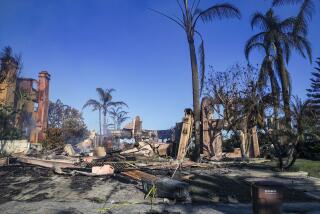No fuel, no embers mean no damage
How is it that some homes and even whole communities in the path of this year’s most destructive wildfire remained islands of green?
James Bried attributes the survival of his property -- an oasis within a charred canyon in San Diego County -- to “the grace of God.”
But the hand of man also had something to do with it.
His house was built in 2000, with an eye toward stopping ember intrusion. Openings in his Spanish tile roof are plugged with mortar. His windows are double-paned. His vents are screened.
And Bried maintains an expansive garden dominated by well-watered succulents. Beyond a lush lawn, he has planted a deep buffer zone of an ice plant variety commonly called red apple aptenia, which is known for its fire-retardant ability.
As fire experts have analyzed why some houses directly in the path of October’s firestorms remained untouched, two things stood out: The surviving houses were built to keep embers out and the grounds maintained to deny the fires fuel.
These principles can be used to save not just one house, like Bried’s, but to spare whole communities.
In five developments in Rancho Santa Fe built to withstand fire, only one home suffered minor damage and none were destroyed as wildfire raged through the area.
In the last decade, fire officials have worked with developers and homeowner associations to create extremely strict fire codes.
They are intended to allow residents to stay safely inside their homes even if it is too late to evacuate.
Each homeowner must maintain a 100-foot zone clear of dead or woody debris and a 50-foot area planted only with fire- resistant vegetation.
Homes and decks cannot hang over the edge of canyons where they could be in a wildfire’s path.
Awnings and roofs must be fire-resistant. Attic vents and chimneys are built to keep out embers.
Even fences have to be fire- resistant where they connect to the house.
“We determined from the [2003] Cedar fire that the wooden fences were the worst,” said Cliff Hunter, the district fire marshal. They “would burn right into the house and catch the eaves on fire.”
In addition, fire officials regularly check whether homeowners have cleared their weeds and removed flammable material, such as dead fronds from palm trees.
If not, Hunter said, “we intervene, and say they need to clean it.” If homeowners fail to do so, fire officials order the cleaning to be done.
“We take the cost of that, and we put it in their property tax bill,” he said.
The rigorous inspections are costly. In Rancho Santa Fe, a wealthy, rural community with a population of 22,000, two full-time fire inspectors check to see if homeowners are clearing weeds or are inappropriately installing flammable vegetation.
By contrast, the entire city of San Diego, population 1.25 million, had two inspectors, who had their hands full responding to complaints about overgrown weeds. Two more were added in October.
In the city of Los Angeles, the Fire Department has 13 charged with monitoring brush clearance.
Fire experts cite one last backup for homeowners in case all else fails: automatic fire sprinklers in homes.
In the case of the single home that was damaged in the five Rancho Santa Fe developments, a piece of particle board left leaning against a garage door ignited, sending flames inside. The garage’s sprinklers extinguished the fire.
More to Read
Start your day right
Sign up for Essential California for news, features and recommendations from the L.A. Times and beyond in your inbox six days a week.
You may occasionally receive promotional content from the Los Angeles Times.








